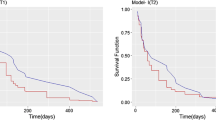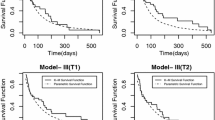Abstract
Traditional survival analysis techniques focus on the occurrence of failures over the time. During the analysis of such events, ignorance of related observed and unobserved covariates may lead to adverse consequences. In this context, frailty models are the viable choice to counter the problem of the unobserved heterogeneity in individual risks to disease and death. In this article, we assume that frailty acts multiplicatively to hazard rate. We propose generalized Lindley (GL) frailty model with Weibull as baseline distribution for hazard function. The Bayesian paradigm of Markov Chain Monte Carlo (MCMC) methodology is used to estimate the model parameters. Subsequently, model comparisons are performed using Bayesian comparison techniques. The popular kidney data set is used to illustrate the results and to demonstrate that better models are recommended.





Similar content being viewed by others
REFERENCES
J. W. Vaupel, K. G. Manton, and E. Stallaed, ‘‘The impact of heterogeneity in individual frailty on the dynamics of mortality,’’ Demography 16, 439–454 (1979).
D. R. Cox, ‘‘Regression models and life tables (with discussion),’’ J. R. Stat. Soc., Ser. B 34, 187–220 (1972).
D. Oakes, ‘‘Bivariate survival models induced by frailties,’’ J. Am. Stat. Assoc. 84 (406), 487–493 (1989).
P. Hougaard, ‘‘A class of multivariate failure time distributions,’’ Biometrika 73, 671–678 (1986).
P. Hougaard, ‘‘Discussion of the paper by D. G. Clayton and J. Cuzick,’’ J. R. Stat. Soc., Ser. A 148, 113–114 (1985).
P. Hougaard, ‘‘Modeling heterogeneity in survival data,’’ J. Appl. Prob. 28, 695–701 (1991).
P. Hougaard, Analysis of Multivariate Survival Data (Springer, New York, 2000).
C. J. Flinn and J. J. Heckman, ‘‘New methods for analyzing individual event histories,’’ in Sociological Methodology, Ed. by S. Leinhardt (Jossey-Bass, 1982), pp. 99–140.
D. D. Hanagal, ‘‘Frailty regression models in mixture distributions,’’ J. Stat. Planning Inference 138, 2462–2468 (2008).
D. D. Hanagal and A. D. Dabade, ‘‘Modeling of inverse Gaussian frailty model for bivariate survival data,’’ Commun. Stat. Theory Methods 42, 3744–3769 (2013).
D. D. Hanagal and A. D. Dabade, ‘‘Comparison of shared frailty models for kidney infection data under exponential power baseline distribution,’’ Commun. Stat.—Theory Methods 44, 5091–5108 (2015).
D. D. Hanagal and A. Pandey, ‘‘Inverse Gaussian shared frailty for modeling kidney infection data,’’ Adv. Reliab. 1, 1–14 (2014).
S. Tyagi, ‘‘Analysis of bivariate survival data using shared inverse Gaussian frailty models: A Bayesian approach,’’ in Predictive Analytics Using Statistics and Big Data: Concepts and Modeling (Bentham Books, 2020), No. 14, pp. 75–88.
D. D. Hanagal and R. Sharma, ‘‘Analysis of bivariate survival data using shared inverse Gaussian frailty model,’’ Commun. Stat.—Theory Methods 44, 1351–1380 (2015).
D. D. Hanagal and A. Pandey, ‘‘Gamma frailty models for bivariate survival data,’’ J. Stat. Comput. Simul. 85, 3172–3189 (2015).
D. D. Hanagal and A. Pandey, ‘‘Shared inverse Gaussian frailty models based on additive hazards,’’ Commun. Stat.—Theory Methods 46, 11143–11162 (2017).
D. D. Hanagal and A. Pandey, ‘‘Gamma shared frailty model based on reversed hazard rate for bivariate survival data,’’ Stat. Prob. Lett. 88, 190–196 (2014).
D. D. Hanagal and A. Pandey, ‘‘Inverse Gaussian shared frailty models with generalized exponential and generalized inverted exponential as baseline distributions,’’ J. Data Sci. 13, 569–602 (2015).
D. D. Hanagal and A. Pandey, ‘‘Gamma shared frailty model based on reversed hazard rate,’’ Commun. Stat.—Theory Methods 45, 2071–2088 (2016).
D. D. Hanagal and A. Pandey, ‘‘Inverse Gaussian shared frailty models based on reversed hazard rate,’’ Model Assist. Stat. Appl. 11, 137–151 (2016).
D. D. Hanagal and A. Pandey, ‘‘Shared frailty models based on reversed hazard rate for modified inverse Weibull distribution as baseline distribution,’’ Commun. Stat. Theory Methods 46, 234–246 (2017).
A. Pandey, D. D. Hanagal, P. Gupta, and S. Tyagi, ‘‘Analysis of australian twin data using generalized inverse gaussian shared frailty models based on reversed hazard rate,’’ Int. J. Stat. Reliab. Eng. 7, 219–235 (2020).
Gupta, ‘‘Bayesian inferences in generalized Lindley shared frailty model with left censored bivariate data,’’ in Advance Research Trends in Statistics and Data Science (MKSES Publ., 2021), pp. 137–157.
D. V. Lindley, ‘‘Fiducial distributions and Bayes’s theorem,’’ J. R. Stat. Soc., B 20, 102–107 (1958).
I. Elbatal, F. Merovci, and M. Elgarhy, ‘‘A new generalized Lindley distribution,’’ Math. Theory Model. 3 (13), 30–47 (2013).
G. S. Mudholkar and D. K. Srivastava, ‘‘Exponentiated Weibull family for analyzing bathtub failure-rate data,’’ IEEE Trans. Reliab. 42, 299–302 (1993).
C. A. Santos and J. A. Achcar, ‘‘A Bayesian analysis for multivariate survival data in the presence of covariates,’’ J. Stat. Theory Appl. 9, 233–253 (2010).
J. G. Ibrahim, C. Ming-Hui, and D. Sinha, Bayesian Survival Analysis (Springer, Berlin, 2001).
J. Geweke, ‘‘Evaluating the accuracy of sampling-based approaches to the calculation of posterior moments,’’ in Bayesian Statistics 4, Ed. by J. M. Bernardo, J. Berger, A. P. Dawid, and A. F. M. Smith (Oxford Univ. Press, Oxford, 1992), pp. 169–193.
A. Gelman and D. B. Rubin, ‘‘A single series from the Gibbs sampler provides a false sense of security,’’ in Bayesian Statistics 4, Ed. by J. M. Bernardo, J. Berger, A. P. Dawid, and A. F. M. Smith (Oxford Univ. Press, 1992), pp. 625–632.
C. A. McGilchrist and C. W. Aisbett, ‘‘Regression with frailty in survival analysis,’’ Biometrics 47, 461–466 (1991).
Author information
Authors and Affiliations
Corresponding authors
Additional information
(Submitted by A. I. Volodin)
Rights and permissions
About this article
Cite this article
Pandey, A., Tyagi, S. Comparison of Multiplicative Frailty Models Under Weibull Baseline Distribution. Lobachevskii J Math 42, 3184–3195 (2021). https://doi.org/10.1134/S1995080222010140
Received:
Revised:
Accepted:
Published:
Issue Date:
DOI: https://doi.org/10.1134/S1995080222010140




